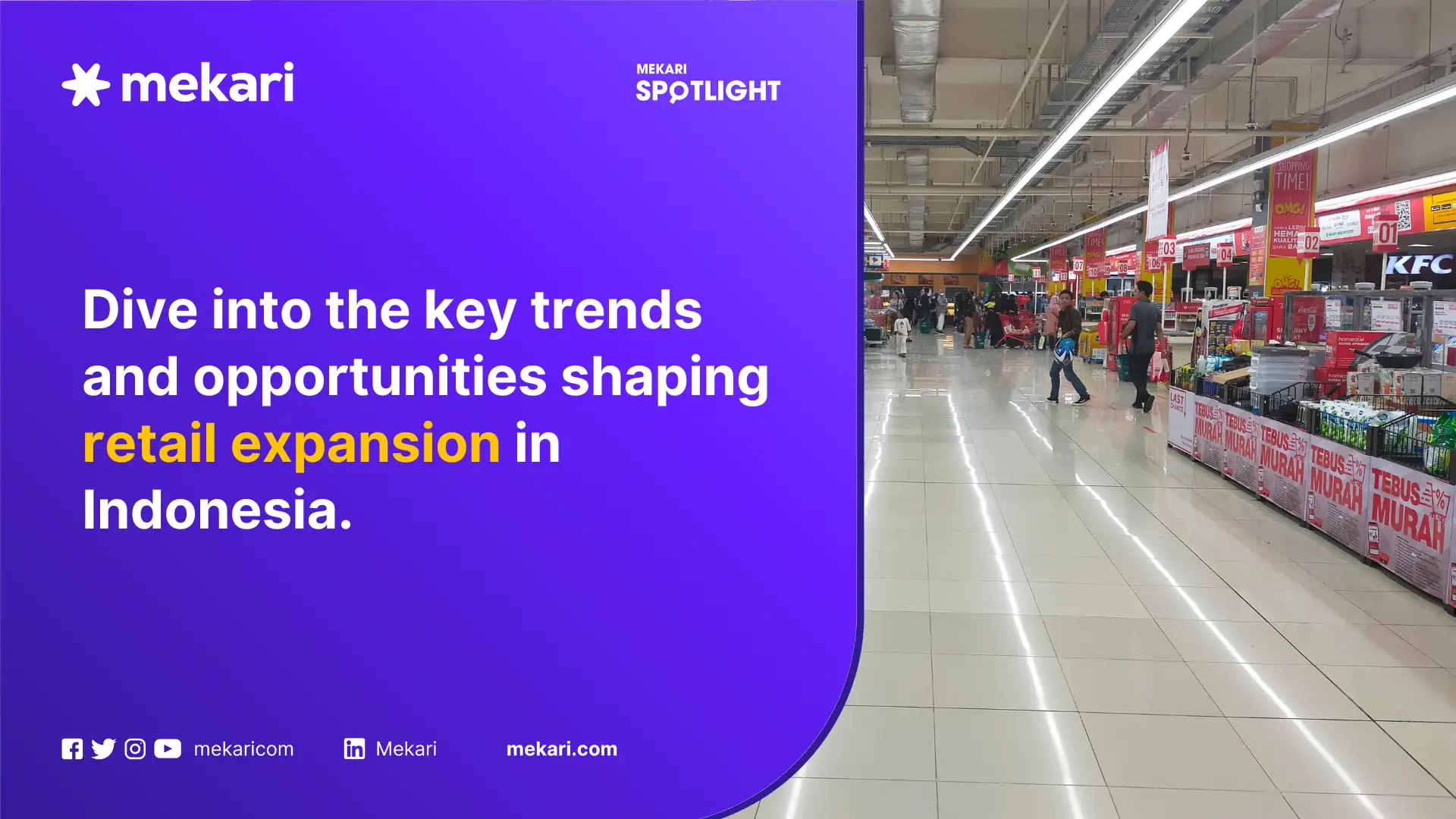Mekari Insight
- Indonesia’s retail market is set to hit USD 243 billion by 2026, driven by a growing middle class and rising tech adoption.
- With more people shopping online, e-commerce is booming, making omnichannel strategies a must for retailers.
- Millennials’ demand for eco-friendly products and AI-driven experiences presents huge opportunities for retailers to stand out.
Indonesia’s retail market is thriving, and with its large, growing middle class, it’s an exciting time for businesses looking to expand. From fashion and electronics to food and beauty, opportunities are abundant across various sectors.
As consumer behavior shifts, especially with the rise of e-commerce, there’s never been a better time to tap into this dynamic market. Let’s dive into the key trends and opportunities shaping retail expansion in Indonesia.
Indonesia retail industry outlook
Indonesia’s retail market is expected to reach USD 243 billion by 2026, driven by urbanization and growing middle-class spending. The rise of e-commerce and tech adoption is reshaping the retail landscape.
The economy grew by 5.03% in early 2023, with a positive outlook of 4.5% to 5.3%. Retail contributes over 10% to the GDP, supported by a growing middle class and millennials’ increasing purchasing power.
Retail exports also saw growth, rising from USD 5.35 million in 2021 to USD 5.93 million in 2022.
Indonesia retail market size
Indonesia’s retail market is expected to grow by USD 49.9 billion, with a 4.7% annual growth rate from 2024 to 2029. This expansion is driven by the increasing popularity of local brands and the growing middle class.
However, challenges such as underdeveloped infrastructure in rural areas, transportation issues, and unreliable power supply can slow down market growth. Additionally, complex regulations around e-commerce and large retail formats pose hurdles.
To succeed, retailers must adapt by partnering with local distributors, investing in technology, and improving supply chain efficiency to better serve the market’s unique needs and stay competitive.
Retail market segmentation in Indonesia
Indonesia’s retail market is growing steadily in both offline and online channels, such as:
Offline retail:
- Includes convenience stores and department stores.
- Focus on essential products like groceries and personal care.
- Digital technology enhances in-store experiences (mobile apps, special offers).
Online retail:
- Rapid growth due to e-commerce, social media, and a rising middle class.
- Supported by digital payments and BNPL (Buy Now Pay Later) options.
Key product categories:
- Food and beverages
- Electrical and electronics
- Apparel and footwear
- Home improvement and household products
Technological trends:
- AI and augmented reality enhance shopping experiences.
- Digital tools optimize inventory and operations.
Customer preferences:
- Sustainability and eco-friendly practices are increasingly important.
- Customer sentiment during specific periods like Ramadan significantly influences sales.
Opportunities in Indonesia’s retail industry
Indonesia’s retail industry presents a wealth of opportunities, driven by a growing middle class and urbanization. Here’s a breakdown of the key drivers and trends in the market:
- Growing middle class & urbanization: As Indonesia’s middle class expands, demand for fashion, electronics, food, and health products is rising, creating a favorable environment for retail growth.
- Tech-savvy millennials & evolving preferences: The rise of millennials and their demand for sustainable, health-conscious products, such as plant-based foods and eco-friendly items, is opening new avenues for innovation.
- Government support for foreign investment: Indonesia offers attractive incentives like tax allowances, duty exemptions, and pro-business policies, making market entry more accessible for foreign companies. Foreign retailers can also own large-scale operations in major urban areas.
- E-commerce growth: With e-commerce adoption surging, digital platforms are becoming essential for retail strategies. Projections show that millions of users will join by 2029, creating ample opportunities for online retail, omnichannel strategies, and digital-first business models.
- Innovation and personalization: Retailers can differentiate themselves by embracing AI and data analytics, enabling personalized, digital-first shopping experiences that meet the evolving demands of Indonesian consumers.
- Opportunities for local brands: Indonesia’s strategic position within ASEAN and the government’s support for infrastructure development provide local brands with significant potential to expand both domestically and internationally.
Indonesia’s retail market is evolving rapidly, with strong opportunities for innovation, digitalization, and expansion—especially for both local and international brands that can tap into shifting consumer preferences and leverage government incentives.
Optimize retail operations by the best retail software in Indonesia
Indonesia’s retail scene is booming, with plenty of room for growth thanks to a growing middle class and an increasing appetite for innovation. The key to tapping into this potential? Streamlining your operations with the right tools.
Mekari is here to help. With its all-in-one software solution, Mekari simplifies everything from inventory management to sales and customer service. It’s the perfect way for retailers to stay ahead of the curve and keep customers happy.
Ready to grow your retail business in Indonesia? Let Mekari help you make it happen.
References
Invest in Asia. ”Retail Industry in Indonesia: Outlook and Opportunities”
Technavio. ”Indonesia Retail Market Analysis, Size, and Forecast 2025-2029”

